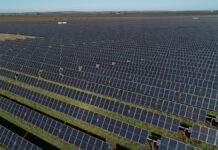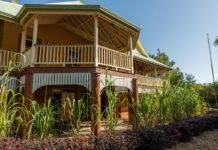
A field day showcasing an innovative hybrid solar/grid power supply project ,which is reducing irrigator electricity costs by 73 per cent, will be held in Bundaberg on Wednesday, 15 May 2019.
The “Adapting Renewable Energy Project” is being funded by the Federal Government’s Australian Renewable Energy Agency (ARENA), with Bundaberg Regional Irrigators Group (BRIG) the administrator.
The project is presenting compelling results with local, national and potentially global benefits.
The field day runs from 11am to 2pm, with courtesy transport provided from Brothers Sports Club, 130 Takalvan St, Bundaberg. There will be a barbecue lunch.
Suppliers and enterprises providing vital components of this ground-breaking project will be on hand including:
- REAQUA
- Sunfam
- Solardyne
- Zener Electric Queensland
- Grundfos Australia will have their ‘Energy Check’ specialist onsite
Bundaberg Regional Irrigators Group (BRIG) team will be on hand, and National Irrigators Council CEO Steve Whan will be at the event.
Sunfam has provided a $500 Lucky Draw Prize of a a 60L Croplands Croppak sprayer, to be drawn on the day.
“This step forward in irrigation and other bulk water usage has huge implications not just nationally, but globally,”
BRIG spokesman Dale Holliss said.
“Any farming or other operation using megalitres of water on an ongoing basis – whether high pressure or trickle – could reap the benefits.
“Tailored technologies to reduce pumping costs for irrigating farmers are desperately needed, whether the crop be sugarcane, cotton, wheat, canola or small crops.”
Bookings are essential. Email Dale_Holliss@bdbcanegrowers.com.au or go to Eventbrite.
About the project
The three-year “Adapting Renewable Energy Project” concludes in 2020 and the project team is able to present compelling results and opportunities that could benefit all farming operations dependent on bulk water usage.
“This field day is a great opportunity to talk to the project team, view the data and speak with the experts around the hybrid system,” Mr Holliss said.
“Australia is already acknowledged for its world-class research, and this project is confirming that status. This knowledge will be shared across the globe to benefit the whole world.”
Mr Holliss said the benefits were not just limited to cost savings.
“This project is in line with global thinking around sustainable production of food and fibre, and maximising use of the natural resource of sunlight, of which Australia has ample supplies,” he said.
“This hybrid technology will empower irrigating farmers to water to suit their crops, not to fit in with power tariffs.
“It also has a major value add – it is putting long-awaited lifestyle choices into irrigated farming. The system can be operated remotely, via a mobile phone or other smart device. A farmer can be at home in their living room, or on holiday, and still be able to turn their pumps on and off.”
The farm on which the solar/grid power project is being trialled just outside Bundaberg is owned by the Killer family.
Josh Killer said that the project had already delivered enormous benefits to his operations, and he would continue with it after the project finished.
“Our farm management strategy is no longer constrained by energy costs, and we are much more able and willing to irrigate according to crop need rather than worrying about the enormous expense of turning on the pumps,” he said.
Mr Killer also is able to be away from his farm, yet still turn on the pumps as required.
Mr Holliss said a range of ways to offer flexible, affordable options around solar / grid combos had already been identified.
“The whole operation sits within a small shed, and the solar panels can be placed on a multi-purpose general shed,” he said.
“The project has utilised existing piping infrastructure, which means that farmers don’t have to undergo an expensive overhaul – they just add the capacity to bring the hybrid elements of solar and grid power together.”
- Solar irrigation trial delivers 70pc energy saving







